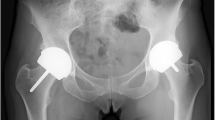Abstract
Due to the increasing number of total hip arthroplasties performed during the last three decades and the limited long-term survival, mainly because of wear, the number of revisions has increased during the last two years. If the implant itself is still considered to be stable, only head and inlay exchange is necessary. This requires comprehensive knowledge of the characteristics of the articulating materials by the surgeon as the wrong choice of wear couple can lead to early failure for a second time. The aim of this paper is to present considerations and strategies for head and inlay exchange in case of failure, either due to wear of the articulation material or of other indications for revision hip arthroplasty.




Similar content being viewed by others
References
Pospischill M, Knahr K (2005) Cementless total hip arthroplasty using a threaded cup and a rectangular tapered stem. Follow-up for ten to 17 years. J Bone Joint Surg Br 87(9):1210–1215. doi:10.1302/0301-620X.87B9.16107
Harris WH (2001) Wear and periprosthetic osteolysis: the problem. Clin Orthop Relat Res 393:66–70
Santavirta S, Bohler M, Harris WH, Konttinen YT, Lappalainen R, Muratoglu O, Rieker C, Salzer M (2003) Alternative materials to improve total hip replacement tribology. Acta Orthop Scand 74(4):380–388. doi:10.1080/00016470310017668
Harris WH (2004) Highly cross-linked, electron-beam-irradiated, melted polyethylene: some pros. Clin Orthop Relat Res 429:63–67
Silva M, Heisel C, Schmalzried TP (2005) Metal-on-metal total hip replacement. Clin Orthop Relat Res 430:53–61
Hamadouche M, Boutin P, Daussange J, Bolander ME, Sedel L (2002) Alumina-on-alumina total hip arthroplasty: a minimum 18.5-year follow-up study. J Bone Joint Surg Am 84-A(1):69–77
MacDonald SJ (2004) Metal-on-metal total hip arthroplasty: the concerns. Clin Orthop Relat Res 429:86–93
Barrack RL, Burak C, Skinner HB (2004) Concerns about ceramics in THA. Clin Orthop Relat Res 429:73–79
Zichner L, Lindenfeld T (1997) In-vivo wear of the slide combinations ceramics-polyethylene as opposed to metal-polyethylene. Orthopade 26(2):129–134
Urban JA, Garvin KL, Boese CK, Bryson L, Pedersen DR, Callaghan JJ, Miller RK (2001) Ceramic-on-polyethylene bearing surfaces in total hip arthroplasty. Seventeen to twenty-one-year results. J Bone Joint Surg Am 83-A(11):1688–1694
Masson B (2009) Emergence of the alumina matrix composite in total hip arthroplasty. Int Orthop 33(2):359–363. doi:10.1007/s00264-007-0484-9
Greenwald AS, Garino JP (2001) Alternative bearing surfaces: the good, the bad, and the ugly. J Bone Joint Surg Am 83-A(Suppl 2 Pt 2):68–72
Jacobs JJ, Hallab NJ (2006) Loosening and osteolysis associated with metal-on-metal bearings: A local effect of metal hypersensitivity? J Bone Joint Surg Am 88(6):1171–1172. doi:10.2106/JBJS.F.00453
Karamat L, Pinggera O, Knahr K (2005) Blood analysis for trace metals in metal-on-metal, ceramic-on-ceramic and metal-on-cross-linked PE bearings in total hip arthroplasty. Hip International 15:136–142
Brodner W, Bitzan P, Meisinger V, Kaider A, Gottsauner-Wolf F, Kotz R (2003) Serum cobalt levels after metal-on-metal total hip arthroplasty. J Bone Joint Surg Am 85-A(11):2168–2173
Allen MJ, Myer BJ, Millett PJ, Rushton N (1997) The effects of particulate cobalt, chromium and cobalt-chromium alloy on human osteoblast-like cells in vitro. J Bone Joint Surg Br 79(3):475–482
Hallab N, Merritt K, Jacobs JJ (2001) Metal sensitivity in patients with orthopaedic implants. J Bone Joint Surg Am 83-A(3):428–436
Park YS, Moon YW, Lim SJ, Yang JM, Ahn G, Choi YL (2005) Early osteolysis following second-generation metal-on-metal hip replacement. J Bone Joint Surg Am 87(7):1515–1521. doi:10.2106/JBJS.D.02641
Willert HG, Buchhorn GH, Fayyazi A, Flury R, Windler M, Koster G, Lohmann CH (2005) Metal-on-metal bearings and hypersensitivity in patients with artificial hip joints. A clinical and histomorphological study. J Bone Joint Surg Am 87(1):28–36. doi:10.2106/JBJS.A.02039
Baur W, Honle W, Willert HG, Schuh A (2005) Pathological findings in tissue surrounding revised metal/metal articulations. Orthopade 34(3):225–226. doi:10.1007/s00132-004-0761-x
Holloway I, Walter WL, Zicat B, Walter WK (2009) Osteolysis with a cementless second generation metal-on-metal cup in total hip replacement. Int Orthop 33(6):1537–1542. doi:10.1007/s00264-008-0679-8
Skinner HB (1999) Ceramic bearing surfaces. Clin Orthop Relat Res 369:83–91
Mittelmeier H, Heisel J (1992) Sixteen-years' experience with ceramic hip prostheses. Clin Orthop Relat Res 282:64–72
Willmann G (2000) Ceramic femoral head retrieval data. Clin Orthop Relat Res 379:22–28
Kempf I, Semlitsch M (1990) Massive wear of a steel ball head by ceramic fragments in the polyethylene acetabular cup after revision of a total hip prosthesis with fractured ceramic ball. Arch Orthop Trauma Surg 109(5):284–287
Suzuki K, Matsubara M, Morita S, Muneta T, Shinomiya K (2003) Fracture of a ceramic acetabular insert after ceramic-on-ceramic THA—a case report. Acta Orthop Scand 74(1):101–103. doi:10.1080/00016470310013752
Lee SC, Jung KA, Nam CH, Kim TH, Ahn NK, Hwang SH (2010) Acetabular screw head-induced ceramic acetabular liner fracture in cementless ceramic-on-ceramic total hip arthroplasty. Orthopedics 33(5). doi:10.3928/01477447-20100329-30
Knahr K, Beck R (2002) An instrument for the insertion of ceramic liners. In: Garino JP, Willmann G (eds) Bioceramics in joint arthroplasty. Proceedings of the 7th International BIOLOX Symposium. Thieme, Stuttgart, pp 71–75
Author information
Authors and Affiliations
Corresponding author
Rights and permissions
About this article
Cite this article
Pospischill, M., Knahr, K. Strategies for head and inlay exchange in revision hip arthroplasty. International Orthopaedics (SICOT) 35, 261–265 (2011). https://doi.org/10.1007/s00264-010-1164-8
Received:
Revised:
Accepted:
Published:
Issue Date:
DOI: https://doi.org/10.1007/s00264-010-1164-8




